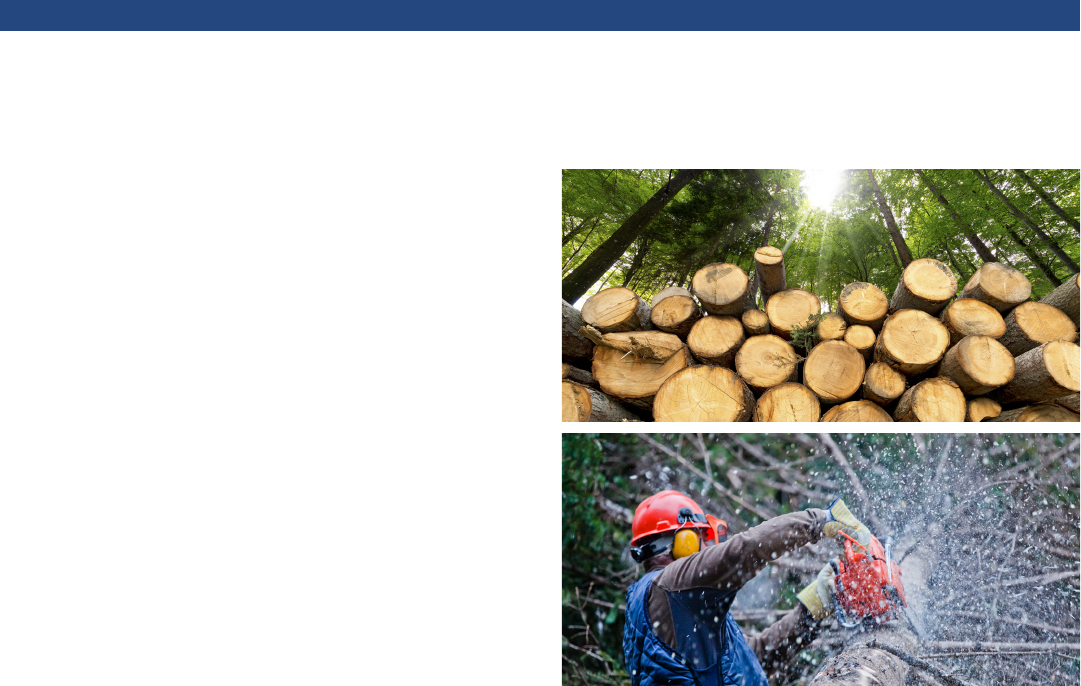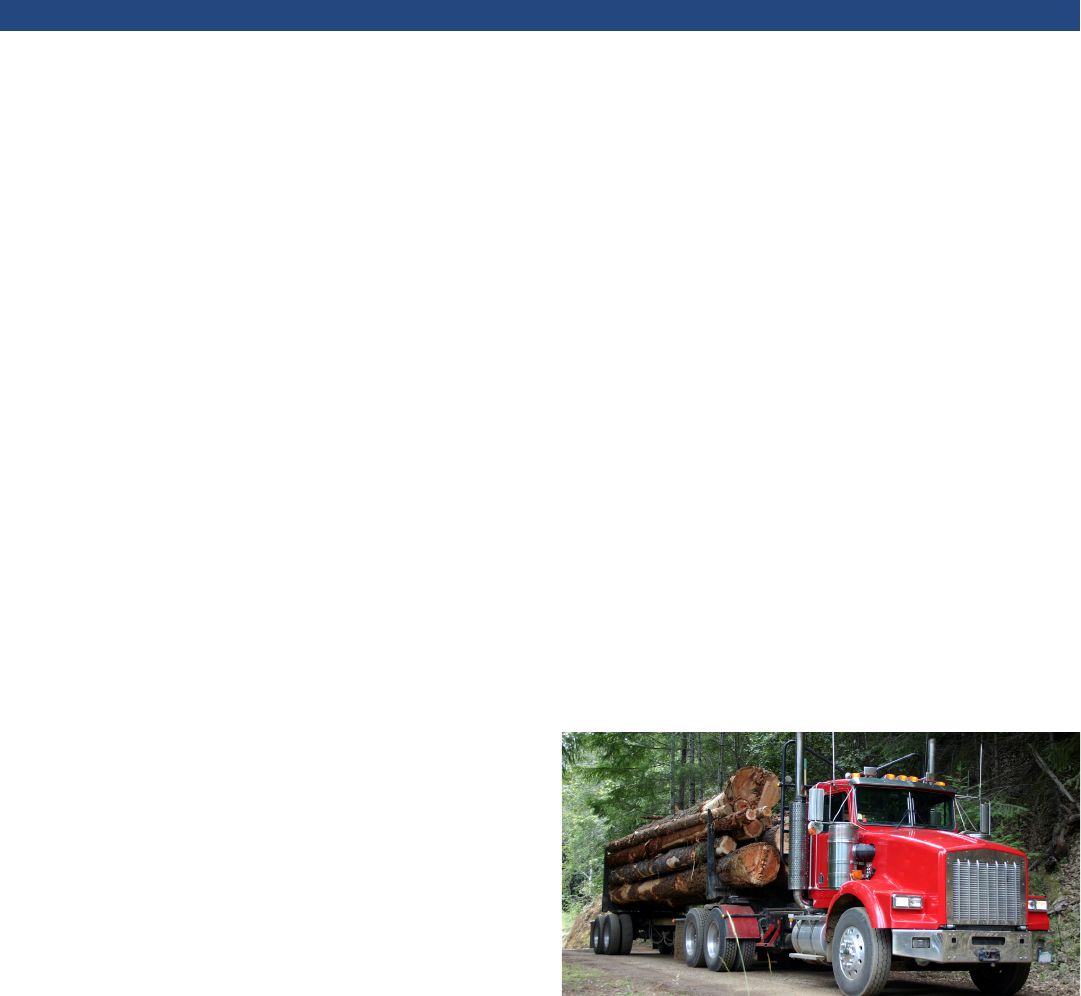
1
WASHINGTON STATE DEPARTMENT OF REVENUE
JULY 2023
Washington state encourages sound forestry pracces
so that present and future generaons can enjoy the
many benets they provide. In addion to scenic and
recreaonal spaces, healthy forests provide:
• An enhanced water supply.
• Reduced soil erosion, storm and ood damage.
• Habitat for wild game.
• Employment opportunies.
• Raw materials for products.
As a way to encourage commercial forestry in Washington
state, landowners may choose to have their land
designated as forest land. This designaon oen results
in a lower assessed value and lower taxes. Specic
requirements must be met to qualify for this designaon.
Requirements for Designated Forest
Land
To request your land be designated as forest land, the
following requirements apply:
• The land must be used primarily for growing and
harvesng mber.
• The land must consist of a single parcel of ve or more
acres; or mulple, conguous parcels totalling ve or
more acres. Residenal home sites are not included in
the ve acre minimum.
• Designated forest land may include land used for
incidental uses that are compable with growing and
harvesng mber, but no more than 10% of the land
may be used for such incidental uses.
• If the land has appurtenances necessary for the
producon, preparaon, or sale of the mber
products, that land may also be included.
• You must comply with forest pracce laws and
regulaons.
• Applicaon must be made to the county assessor.
Applicaon for Designated Forest Land
You can get an applicaon for Designated Forest Land
from your local assessor’s oce. In some counes, an
applicaon fee may also apply. The applicaon requires
the following informaon:
• A legal descripon of, or assessor's parcel numbers
for, all land you want designated as forest land.
• The date or dates of acquision of the land.
• A brief descripon of the mber on the land, or if the
mber has been harvested, your plan for restocking.
• If one exists, a copy of the mber management plan
for the land, prepared by a forester or a person
with adequate knowledge of mber management
pracces.
• If a mber management plan exists, an explanaon of
the extent to which the management plan has been
implemented.
• Whether the land is used for grazing.
• Whether the land has been subdivided or a plat has
been led with respect to the land.
• Whether the land is managed in compliance with the
restocking, forest management, re protecon, insect
and disease control, and forest debris provisions of
Title 76 RCW or any applicable rules under Title 76
RCW.
• Whether the land is subject to forest re protecon
assessments under RCW 76.04.610.
• Whether the land is subject to a lease, opon, or
other right that permits it to be used for any purpose
other than growing and harvesng mber.
• A summary of your past and current experience
growing and harvesng mber.
Designated Forest Land

2
WASHINGTON STATE DEPARTMENT OF REVENUE
• A statement that you are aware of the potenal
tax liability involved when the land is no longer
designated as forest land.
• An armaon that the statements contained in the
applicaon are true and that the land described in
the applicaon meets the denion of forest land in
RCW 84.33.035.
• A descripon and/or map showing what areas of the
land are used for incidental uses compable with the
denion of forest land in RCW 84.33.035.
The assessor may also require an applicant to provide
a mber management plan when an applicaon for
classicaon or reclassicaon into designated forest
land is submied. For addional informaon on mber
management plans, please refer to the Guidelines for
Timber Management Plans publicaon or visit www.
foresax.dor.wa.gov.
Submit your completed applicaon to the assessor’s oce
by December 31.
If approved, designated status begins January 1 the year
aer you apply. If the assessor does not nofy you as to
whether your applicaon was approved or denied prior
to July 1 of the year aer you apply, the applicaon is
automacally approved. If denied, you may appeal the
denial to the county board of equalizaon.
Valuaon of Designated Forest Land
The Department of Revenue annually adjusts and ceres
forest land values to be used by county assessors in
preparing assessment rolls. The assessors assign the
forest land values to the property based upon land
grades and operability classes. The mber on Designated
Forest Land is exempt from real property taxes but is
subject to mber excise tax under chapter 84.33 RCW.
For addional informaon on mber excise tax, please
refer to the Timber Excise Tax publicaon or visit www.
foresax.dor.wa.gov.
Removal from Designated Forest Land
Land may be removed from designaon if:
• You choose to remove the land and you nofy the
assessor in wring.
• You sell or transfer the land to an ownership that
makes the land exempt from ad valorem taxaon.
• You sell or transfer the land to a new owner that does
not sign a noce of forest land connuance.
• Determinaon by the assessor, aer giving the owner
wrien noce and an opportunity to be heard, that:
1. The land is no longer primarily devoted to and used
for growing and harvesng mber.
2. You did not comply with a nal administrave or
judicial order with respect to a violaon of the
restocking, forest management, re protecon,
insect and disease control, and forest debris
provisions of Title 76 RCW or any applicable rules
under Title 76 RCW.
3. Restocking the land has not occurred to the extent
or within the me specied in your designaon
applicaon.
Compensang tax
Upon removal, you will be required to pay compensang
tax unless the removal meets one of the excepons
outlined in RCW 84.33.140(13) (14), or(15). The amount
of compensang tax is the dierence between the last
Designated Forest Land value and the new assessed value
of the land. This amount is then mulplied by the last
levy rate extended against the land and mulplied by the
number of years the land was designated as forest land,
not to exceed nine. Compensang taxes will also be due
on the land from January 1 of the year the designaon is
removed up to the removal date.
Reclassicaon of Designated Forest
Land
You may request the land to be reclassied (subject to
all applicable qualicaons for each classicaon) to the
Current Use Program outlined in chapter 84.34 RCW,
without paying the compensang tax. The Current Use
Program oers three classicaons:
• Open Space Land.
• Farm and Agricultural Land.
• Timber Land.
For more informaon on these classicaons, please refer
to the Open Space Taxaon Act publicaon.

3
WASHINGTON STATE DEPARTMENT OF REVENUE
Appeals
You may appeal the denial of your applicaon for inial
classicaon or reclassicaon as Designated Forest
Land to the county board of equalizaon. You may also
appeal any removals from designaon as well as the new
assessed value used to calculate the compensang tax.
Need more informaon?
Please contact either your local assessor’s oce or the
Property Tax Division at 360-534-1400.
Department of Revenue Taxpayer Assistance
Call our Telephone Informaon Center 1-800-647-7706.
To request this document in an alternate format, please
complete the Accessibility Request Form or call 360-705-
6705. Teletype (TTY) users please dial 711.
dor.wa.gov
This fact sheet provides general information regarding Designated Forest
Land. The information is current at the date of publication. Please note
subsequent law changes may supersede or invalidate some of this
information.
PT0049 07/23
